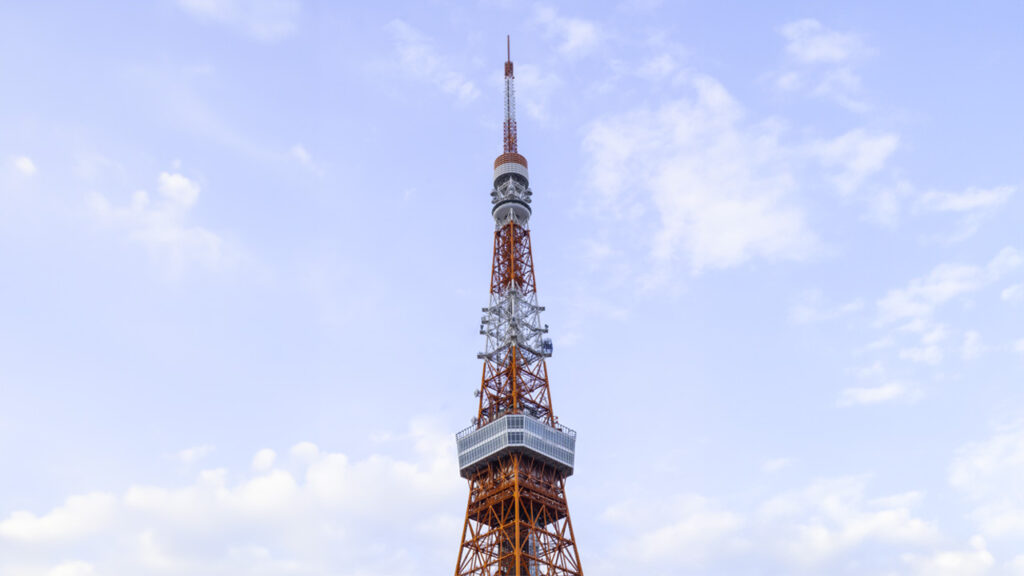Rising gracefully over Tokyo’s skyline, Tokyo Tower is far more than just an iconic tourist destination or symbol of Japan’s post-war recovery. At 333 meters tall, this vibrant red-and-white structure embodies decades of seismic engineering innovation, standing as a living example of how Japan continues to confront and adapt to its greatest natural threat — earthquakes.
- The Vision Behind Tokyo Tower
- The Tower’s Unique Earthquake-Resistant Design
- Adapting to Japan’s Evolving Seismic Standards
- The 1995 Retrofitting: A Masterclass in Seismic Innovation
- How Much Shaking Can Tokyo Tower Endure?
- Beyond Structure: Tokyo Tower’s Comprehensive Safety Systems
- Tokyo Tower as a Symbol of Seismic Resilience
- Summary
The Vision Behind Tokyo Tower
When construction of Tokyo Tower was completed in 1958, Japan was emerging from the devastation of World War II. Inspired by Paris’s Eiffel Tower but surpassing it in height, Tokyo Tower became a bold symbol of Japan’s growing industrial and technological capabilities.
But while its outward appearance echoes European influences, Tokyo Tower’s structural design was uniquely adapted to Japan’s volatile seismic environment.
The Tower’s Unique Earthquake-Resistant Design
From the beginning, Tokyo Tower was engineered with earthquakes in mind — a necessity in one of the world’s most active seismic zones. Its design incorporates several key features:
- Hybrid Foundation: A deep reinforced concrete base anchors the structure securely into the ground, reducing the risk of overturning during seismic activity.
- Steel Truss Structure: Over 4,000 tons of steel form a flexible lattice framework, allowing the tower to sway and absorb energy rather than resisting movement rigidly.
- Aerodynamic Form: The gradually narrowing silhouette minimizes wind resistance and reduces the impact of lateral forces.
At the time of its completion, it was the tallest self-supporting steel tower in the world, representing a triumph of both architectural ambition and structural resilience.
Adapting to Japan’s Evolving Seismic Standards
Perhaps what makes Tokyo Tower most remarkable is its ability to evolve alongside advancements in earthquake science. Built according to 1950s seismic codes, it initially reflected the best available knowledge of the time. But as devastating earthquakes — particularly the 1995 Great Hanshin (Kobe) Earthquake — exposed weaknesses in older structures, Japan dramatically revised its seismic standards.
In response, Tokyo Tower underwent extensive retrofitting and seismic reinforcement to meet these new, more rigorous criteria. These updates reflect Japan’s broader commitment to continual improvement in the face of seismic risk.
The 1995 Retrofitting: A Masterclass in Seismic Innovation
The upgrades to Tokyo Tower after the Great Hanshin Earthquake were both sophisticated and forward-thinking. Key improvements included:
- Steel Pipe Braces: Installed to increase lateral strength and stabilize the tower against horizontal ground shaking.
- Damping Devices: Specialized shock absorbers that dissipate seismic energy, reducing the amplitude of vibrations.
- Foundation Reinforcement: Additional structural supports were added to strengthen the tower’s anchorage during intense seismic waves.
Together, these retrofits transformed Tokyo Tower into a structure that now complies with modern seismic codes, extending its operational life while enhancing safety for visitors and staff.
Explore Tokyo Tower engineering books on Amazon
How Much Shaking Can Tokyo Tower Endure?
According to current assessments, Tokyo Tower is now designed to withstand earthquakes up to magnitude 7 on the Japan Meteorological Agency (JMA) seismic intensity scale — equivalent to the shaking experienced during the Great Hanshin Earthquake. This level of resilience is particularly impressive given the tower’s age and height.
However, as with many tall structures, engineers remain vigilant about long-period ground motions — slower seismic waves that can amplify shaking in high-rise buildings. These complex effects continue to be a subject of advanced seismic research in Japan.
Beyond Structure: Tokyo Tower’s Comprehensive Safety Systems
While much attention is given to the tower’s structural upgrades, its overall safety strategy includes multiple non-structural measures that further enhance its resilience:
- Advanced Earthquake Early Warning System: Provides critical seconds of advance notice to activate emergency protocols.
- Routine Seismic Diagnostics: Regular inspections and real-time monitoring ensure any issues are quickly identified and addressed.
- Evacuation Planning: Detailed escape routes and staff training minimize risks for visitors during an emergency.
- Emergency Supplies: Stockpiled resources are readily available to support occupants if prolonged sheltering becomes necessary.
These systems reflect Japan’s holistic approach to disaster preparedness, combining engineering, technology, and operational readiness.
Tokyo Tower as a Symbol of Seismic Resilience
In many ways, Tokyo Tower reflects Japan’s national ethos toward earthquakes: respect for nature’s power, humility in the face of uncertainty, and an unyielding drive for innovation. Its survival and evolution over more than six decades serve as a living example of how careful design, continual maintenance, and scientific progress can protect even the most iconic landmarks.
Summary
Tokyo Tower is far more than an architectural landmark — it’s a masterclass in earthquake engineering. From its innovative hybrid structure in the 1950s to its modern seismic retrofits after the Great Hanshin Earthquake, the tower embodies Japan’s unique ability to blend tradition with cutting-edge science. As visitors gaze up at its gleaming frame, they’re not only witnessing a piece of history but also a monument to human ingenuity in one of the most earthquake-prone regions on Earth.


